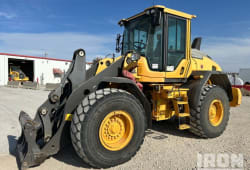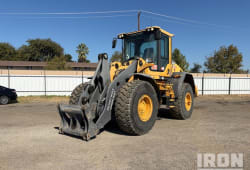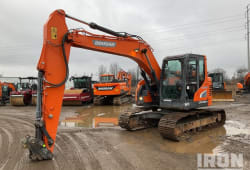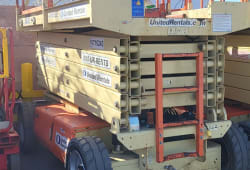10 Key Insights from ENR FutureTech 2022
17 Min read
)
June 15, 2022
Over the past 15 years, the ENR FutureTech conference hosted by Engineering New-Record (ENR) has been the place where leaders in the construction industry congregate to learn, network and trade notes around all things related to Construction Technology. While the conference went virtual throughout the Covid-19 pandemic in 2020 and 2021, this year marked a return to the conference being hosted in person in downtown San Francisco, California.
In this article, our team at Boom & Bucket rounds up the top 10 key insights from this year's ENR FutureTech conference for anyone who wasn't able to attend.
10. The United States is seeing a 9% increase in Construction starts in 2022
On the last day of the conference, Steve Jones from Dodge Data & Analytics provided a quick economic overview of some top construction technology trends and key economic trends impacting the construction industry. Some noteworthy data points include:
Construction starts in the United States will grow 9% year over year in 2022 to over $1 Trillion.
Residential units growth rate is easing as rising interest rates are expected to have a cooling effect on home buying. Within the residential sector however, construction has shifted away from large centers (likely driven by the rise of remote work).
As residential construction shifts to new areas, retail construction is also benefiting.
Within commercial, there is some unevenness: hotels, office space are facing a slow recovery whereas warehouse construction (bolstered by a rise in eCommerce) is poised to grow by 15% to $54.4B in 2022.
Due to increases in on-shoring due to the supply chain crunch, manufacturing construction starts will grow by 26% to $37.9B in 2022.
Healthcare construction starts are also seeing robust growth of 11% to $33.2B in 2022 however the values are more skewed towards regions seeing growing populations of retirees.
Last but not least, highway and bridge starts will increase by 14% in 2022 to a total of just over $90B ($22B in bridges and $68B in streets & highways)
:format(webp))
Source: Dodge Data & Analytics
9. Big infrastructure spending needs to be supported by seamless digital data exchange and digital project delivery
On the first full day of the conference, a keynote presentation was delivered by R. David Unkefer of the US Department of Transportation (DOT) Federal Highway Administration (FHWA) as well as George Lukes of the Utah DOT. In their talk, they outlined how the new infrastructure bill will result in the US DOT FHWA delivering $350B in bridges and highways over the next 5 years. To help enable this work, there is an additional $100M in funding earmarked for the administration to invest in digital tools, data exchange and project management and delivery ($20M per year for 5 years).
While the vision is to ultimately get to a point where there is a BIM model for the asset management every project that serves as the "legal document" governing what will get built by contractors, the organization is still working on solving data interoperability and fragmentation issues that make it hard to create a high quality model in the first place. In order to solve this, the US DOT FHWA is advocating and actively supporting efforts to develop an open and standards based BIM for Infrastructure methodology. While this effort is not an easy lift, getting to a "single source of truth" is seen as critical in order to get accurate models and ultimately digital twins that can then be leveraged throughout the construction project management and of that asset (road or bridge) throughout its useful life.
8. BIM and Digital twins will be used for simulation, total asset lifecycle management but level of detail needs to be practically calibrated
During a session called "Digital Twins Grow Up", John Turner (Gafcon Digital), Salla Eckhardt (Microsoft) and Ivan Panushev (Amazon Web Services) shared insight on how Digital Twin technology adoption was trending as well as some of technology trends and the major challenges that need to be addressed in digital transformation.
Across the panel, everyone agreed that there continues to be a challenge around getting all of the right input data into a single platform in a manner that is standardized and usable. For example, there is BIM data, GIS data, IoT data, virtual model augmented reality, capture data, etc. Once the data is under control, you then need sufficient expertise and tooling to build accurate models off of the data which can be leveraged to create visualizations, simulations, etc as the outputs for specific use cases.
Some of the top use cases for Digital Twin technology that was mentioned by the panel include:
Improve asset performance (i.e., manage the operating costs)
Enable strategic planning regarding future capital expenses
Enhance productivity of field operators
Connect remote experts
Enhance tenant experience
Improve field service
Reduce carbon footprint of the asset
Amazon also shared how they were using digital twins of new warehouses under the construction process to start training their army of robots that are used for order fulfillment in advance.
In a follow-up session called "Lifecycle Thinking with BIM", Geoff Neumayr (Chief Development Officer, San Francisco International Airport, Planning, Design & Construction), brought a lot of the above concepts home by sharing a real-world examples of how BIM and Digital Twin technology was being employed by the project manager for construction projects at SFO airport. Over the past 15 years, the ENR FutureTech conference hosted by Engineering New-Record (ENR) has been the place where leaders in the construction industry congregate to learn, network, and trade notes around all things related to Construction Technology. While the conference went virtual throughout the Covid-19 pandemic in 2020 and 2021, this year marked a return to the conference being hosted in person in downtown San Francisco, California.
In this article, our team at Boom & Bucket rounds up the top 10 key insights from this year's ENR FutureTech conference for anyone who wasn't able to attend.
:format(webp))
7. Safety gains to be driven by adoption of VR training platforms
During a panel presentation titled "Innovative Safety Tech Shows Real Results", Matthew Vitti of Room Scale Labs (a San Diego-based company that specializes in the development of VR-delivered training and machine learning platforms) made the ROI case for shifting job site safety training to virtual reality. Some of the data that was shared included:
43% reduction in on-site safety incidents for workplaces that employed VR training
$27,500 average cost of VR Safety Training Development vs. $44,000 per incident avg. cost per injury as well as $1,310,000 cost per fatality.
:format(webp))
6. Reality and visual data capture continues to an area of rapid adoption
During a panel called "Image-Based Project Tracking and Management and Robotic Deployment", Lana Graf (CEO of Nextera Robotics) along with Eric Cushman (Operations Manager at Gilbane Building Co) shared details of how they partnered to create a fleet of stair climbing autonomous rover robots with a full of array of sensors and data capture instruments (e.g. LIDAR, 360-degree cameras, depth cameras, IMUs, etc) to automatically capture project progress data in a "zero-touch" manner. In doing so, they were able to eliminate the gap in information modeling, productivity, control quality, increase speed, and reduce waste.
According to Lana, commoditization of robotic hardware is here today however the construction industry in particular suffers from a lack of real "solutions" that are integrated, scaleable, and focus on specific problems. The path to commercialization in construction professionals her opinion, requires technology companies to closely partner with builders and construction firms to create end-to-end solutions.
:format(webp))
5. Labor shortages have led to implementation of workforce management practice as a priority
One of the hot topics during the conference was the labor shortage impacting the construction industry as a whole. For example, according to the Associated Builders and Contractors 2022 Workforce Shortage Analysis, the construction industry needs more than a half a million construction workers, above its current pace of hiring in order to meet demand in 2022. This is not a new issue but it was interesting to see how the challenge of finding enough skilled labor has resulted in more contractors investing in more sophisticated digitization of their workforce planning tools to help ensure that they can be more efficient with the resources that they do have.
Specifically, contractors are getting off of siloed spreadsheets that have previously been used for more rudimentary workforce planning onto tools that are better suited to support large scale and are more real-time and proactive. For example, Swinerton mentioned how they had 4000 employees across 20 different divisions all with different processes for labor planning. It was impossible to forecast 3 years in advance and make an effective plan for hiring needs. By adopting LaborChart (a Procore-owned workforce planning tool), they were able to centralize all their data and gain the visibility and transparency that they required. The tool has yielded both hard and soft ROI in the sense that they have been able to demonstrate savings on actual costs per billable craft laborers as well as "quality of work life" improvements that can improve employee retention (e.g., automated text messages that help communicate where to go each day vs. wasting time on the phone).
One of the biggest challenges that innovators and entrepreneurs face in launching new technologies, innovative solutions, and products within the construction industry is being able to do upfront market research and customer discovery work prior to building a minimum viable product (MVP) and raising venture capital. To better support innovation and cultivate groundbreaking ideas that have the potential to drive a big impact within the industry, Turner Construction has partnered with OMERS Ventures to launch a first-of-its-kind Entrepreneur-In-Residence (EIR) program.
The program is structured around a 90-day process in which hand-picked entrepreneurs are given the opportunity to embed themselves inside Turner, learn from internal employees, develop ideas/solutions, and build initial prototypes. If a concept shows that it has legs, entrepreneurs are given the opportunity to raise funding for the business from OMERS and Turner who take equity in construction projects and continue to help get the new venture off the ground.
James Barrett of Turner Construction walks through how the EIR program helps entrepreneurs go from idea to MVP in 90 days.
:format(webp))
4. Large ENR400 firms continue to invest in internal innovation teams and incubation of new construction tech.
One of the biggest challenges that innovators and entrepreneurs face in launching new technologies, innovative solutions and products within the construction industry is being able to do upfront market research and customer discovery work prior to building a minimum viable product (MVP) and raising venture capital. To better support innovation and cultivate ground breaking ideas that have the potential to drive big impact within the industry, Turner Construction has partnered with OMERS Ventures to launch a first of its kind Entrepreneur-In-Residence (EIR) program.
The program is structured around a 90 day process in which hand picked entrepreneurs are given the opportunity to embed themselves inside Turner, learn from internal employees, develop ideas/solutions and build initial prototypes. If a concept shows that it has legs, entrepreneurs are given the opportunity to raise funding for the business from OMERS and Turner who take equity in construction project and continue to help get the new venture off the ground.
:format(webp))
James Barrett of Turner Construction walks through how the EIR program helps entrepreneurs go from idea to MVP in 90 days.
3. IoT, Cameras and Sensors are coming together to enable real-time monitoring and predictive analytics for critical systems in buildings and infrastructure
During a session on "Infrastructure Intelligence", Chrissy Thom (SVP Growth, Strategy & Solutions at Jacobs) shared some key innovations that are taking shape in regards to artificial intelligence and Smart Infrastructure technologies. Some of the interesting technologies that she gave a quick overview on included:
Intelligent Transportation Systems (ITS)
Road User Charging (RUC)
Smart Street Lights that leverages real time data including things such as weather
Automated condition monitoring or water systems and smart sewers (e.g., Cameras and IoT sensors inside pipes that can inform maintenance needs prior to any major repairs being required)
:format(webp))
2. Construction robotics moving beyond pilots to commercialization and the rise of design for robotics
One of the most well attended breakout sessions of the conference was "Integrating Robotics". During this presentation, Gaurav Kikani (VP of Strategy, Operations and Finance at Built Robotics), Keith Churchill (Chief Innovation Officer at Bechtel Global) and Ken Burke (Global Operations Manager at Bechtel Equipment Operations) shared some key learnings from a pilot that they jointly executed in late 2021 to dig a large trench using a Built Robotics Exosystem equipped autonomous excavator on construction site of a Utility Scale Solar project in Texas.
Specifically, the presentation cited results that indicated that Built's autonomous excavator was able to do repetitive tasks and achieve 93% uptime at a productivity rate of 191 LF (linear feet) / hour. Extrapolated over a longer period of time, these results suggested that the autonomous machine would be able to achieve productivity gains of 45% over a traditional human operated excavator performing the same task.
While these results are promising, Gaurav talked in great detail about how the technology is only scratching the surface of what is possible and that initial commercialization would be focused on simpler tasks in rural areas where a skilled equipment operator's time could be better spent working on other things. The group also talked about how as this technology is getting proven in the field, there is a feedback loop back into the traditional construction and design process to better setup future projects to be capable of leveraging such autonomous technology.
Built's approach wearable technology is unique in the sense that its exosystem hardware can be installed on equipment manufactured by many different OEMs and can even be installed on older used excavators vs. strictly late model year versions.
:format(webp))
1. Emergence of new job roles and titles for those trained to instrument and operate construction robots
Another key insight coming out of the "Integrating Robotics" breakout session was that the job site of the future would need to have a new type of construction worker role: Robotic Equipment Operator (REO). As job and modular construction sites begin to utilize an increasing number of autonomous and robotic machines to perform a variety of tasks, individuals who are trained and skilled in the safe instrumentation, monitoring, performance management, and maintenance of a robotic fleet will be important.
Built Robotics is doing its part to get ahead of the curve on this matter. It recently stood up a specialized REO training program and has partnered with some of construction companies and the major unions in the space to help ensure that the workforce of the future will have the skills necessary to run job sites in which human workers and robotics work together hand-in-hand.
:format(webp))
Conclusion
ENR FutureTech is a great conference for professionals in the AEC industry who are looking to learn more about emerging technologies, trends and best practices being employed to push the industry forward. If you are interested in attending the conference, you can learn more and register today!
In the heart of San Francisco, construction visionaries and tech enthusiasts gathered at ENR FutureTech 2022, held from June 8th to 10th at the esteemed Hilton San Francisco Union Square. This premier event served as a nexus for leaders in construction technology, architecture, and engineering, offering two days filled with illuminating sessions, unparalleled networking opportunities, and immersive discussions on revolutionizing construction productivity, profitability, and safety.
"Engaging Insights: 10 Takeaways from ENR FutureTech 2022's Interactive Sessions"
Within the vibrant landscape of San Francisco, industry pioneers and tech aficionados converged at ENR FutureTech 2022, held from June 8th to 10th at the prestigious Hilton San Francisco Union Square. This premier event served as a meeting point for leaders in construction technology, architecture, and engineering, offering two days brimming with enlightening sessions, unparalleled networking opportunities, and immersive discussions aimed at redefining construction productivity, profitability, and safety.
Here are 10 dynamic insights culled from the industry's elite presentations and highly interactive sessions:
Digital Evolution: Redefining Construction Dynamics: The event resonated with a resounding call to embrace digitalization across all construction phases, igniting a path toward efficiency and innovation.
Spotlight on Autodesk Construction Cloud: Booth #34 stood as a testament to how Autodesk Construction Cloud enhances visibility into the construction lifecycle, enabling data-driven decision-making.
Innovative Technologies Steer Progress: Cutting-edge tech like Building Information Modeling (BIM), IoT, and drones took center stage, showcasing their pivotal roles in reshaping the industry landscape.
Data: The Precious Commodity of Construction: Presenters emphasized the pivotal role of data in optimizing operations, elevating productivity, and mitigating risks.
Safety: A Pillar of Advancement: ENR FutureTech spotlighted how technology bolsters safety measures, ensuring a secure working environment through interactive sessions.
The Power of Collaborative Platforms: The transformative potential of collaborative platforms was underscored, fostering seamless communication and coordination among project stakeholders during interactive discussions.
Revival of Prefabrication & Modular Construction: Insights highlighted the resurgence of prefabrication and modular construction, as catalysts for speed, quality, and cost-effectiveness, in interactive panels.
Sustainability's Imperative Role: Visionaries emphasized the nexus between sustainability and productivity, showcasing how green practices drive efficiency gains during these interactive engagements.
Upskilling the Construction Workforce: Discussions delved deep into the importance of equipping the workforce with digital skills to harness evolving technologies, fostering interactive learning experiences.
Charting the Path Ahead: ENR FutureTech culminated with a shared vision of a future where innovation continues to steer the construction industry toward unprecedented growth and excellence through engaging, interactive sessions.
From intimate networking sessions to thought-provoking presentations, ENR FutureTech 2022 illuminated the transformative potential of technology and collaboration in reshaping construction's future. The event served as a testament to the industry's commitment to embracing innovation, fostering interactive engagement, and propelling progress, productivity, and unparalleled success.














